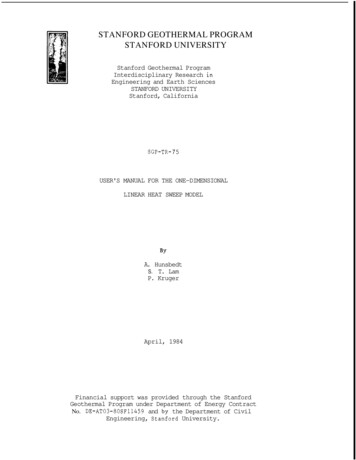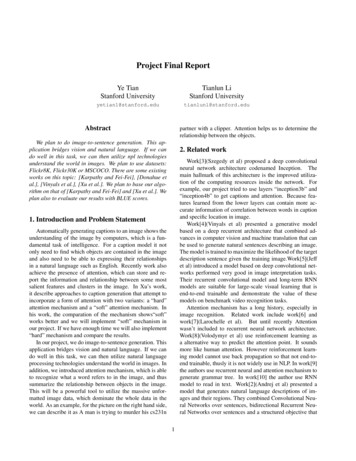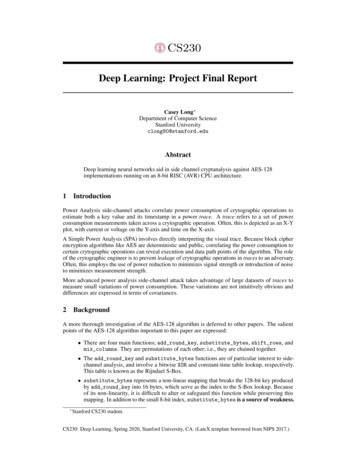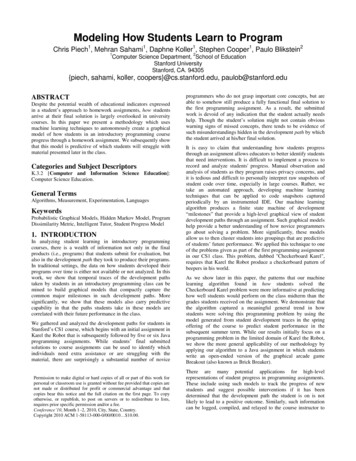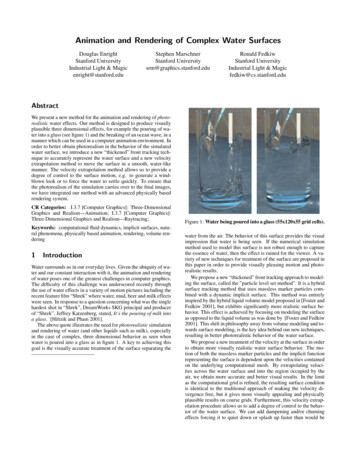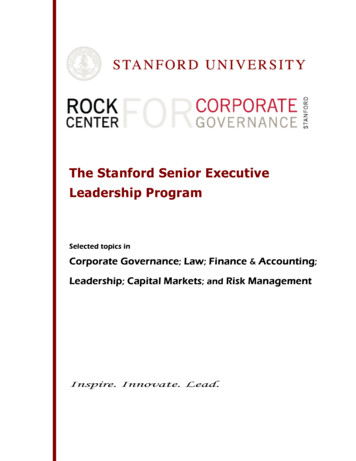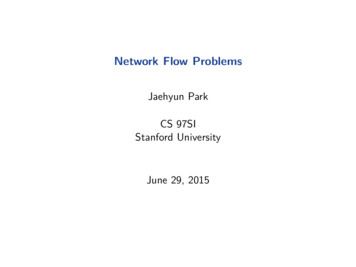
Transcription
Network Flow ProblemsJaehyun ParkCS 97SIStanford UniversityJune 29, 2015
OutlineNetwork Flow ProblemsFord-Fulkerson AlgorithmBipartite MatchingMin-cost Max-flow AlgorithmNetwork Flow Problems2
Network Flow Problem A type of network optimization problemArise in many different contexts (CS 261):– Networks: routing as many packets as possible on a givennetwork– Transportation: sending as many trucks as possible, whereroads have limits on the number of trucks per unit time– Bridges: destroying (?!) some bridges to disconnect s from t,while minimizing the cost of destroying the bridgesNetwork Flow Problems3
Network Flow Problem Settings: Given a directed graph G (V, E), where each edgee is associated with its capacity c(e) 0. Two special nodessource s and sink t are given (s 6 t) Problem: Maximize the total amount of flow from s to tsubject to two constraints– Flow on edge e doesn’t exceed c(e)– For every node v 6 s, t, incoming flow is equal to outgoing flowNetwork Flow Problems4
Network Flow Example (from CLRS) Capacities Maximum flow (of 23 total units)Network Flow Problems5
Alternate Formulation: Minimum Cut We want to remove some edges from the graph such thatafter removing the edges, there is no path from s to t The cost of removing e is equal to its capacity c(e) The minimum cut problem is to find a cut with minimumtotal cost Theorem: (maximum flow) (minimum cut) Take CS 261 if you want to see the proofNetwork Flow Problems6
Minimum Cut Example Capacities Minimum Cut (red edges are removed)Network Flow Problems7
Flow Decomposition Any valid flow can be decomposed into flow paths andcirculations––––s a b t: 11s c a b t: 1s c d b t: 7s c d t: 4Network Flow Problems8
OutlineNetwork Flow ProblemsFord-Fulkerson AlgorithmBipartite MatchingMin-cost Max-flow AlgorithmFord-Fulkerson Algorithm9
Ford-Fulkerson Algorithm A simple and practical max-flow algorithm Main idea: find valid flow paths until there is none left, andadd them upHow do we know if this gives a maximum flow? – Proof sketch: Suppose not. Take a maximum flow f and“subtract” our flow f . It is a valid flow of positive total flow.By the flow decomposition, it can be decomposed into flowpaths and circulations. These flow paths must have beenfound by Ford-Fulkerson. Contradiction.Ford-Fulkerson Algorithm10
Back Edges We don’t need to maintain the amount of flow on each edgebut work with capacity values directlyIf f amount of flow goes through u v, then:– Decrease c(u v) by f– Increase c(v u) by f Why do we need to do this?– Sending flow to both directions is equivalent to canceling flowFord-Fulkerson Algorithm11
Ford-Fulkerson Pseudocode Set ftotal 0Repeat until there is no path from s to t:––––Run DFS from s to find a flow path to tLet f be the minimum capacity value on the pathAdd f to ftotalFor each edge u v on the path: Decrease c(u v) by fIncrease c(v u) by fFord-Fulkerson Algorithm12
Analysis Assumption: capacities are integer-valued Finding a flow path takes Θ(n m) time We send at least 1 unit of flow through the pathIf the max-flow is f , the time complexity is O((n m)f ) – “Bad” in that it depends on the output of the algorithm– Nonetheless, easy to code and works well in practiceFord-Fulkerson Algorithm13
Computing Min-Cut We know that max-flow is equal to min-cut And we now know how to find the max-flow Question: how do we find the min-cut? Answer: use the residual graphFord-Fulkerson Algorithm14
Computing Min-Cut “Subtract” the max-flow from the original graphFord-Fulkerson Algorithm15
Computing Min-Cut Mark all nodes reachable from s– Call the set of reachable nodes A Now separate these nodes from the others– Cut edges going from A to V AFord-Fulkerson Algorithm16
Computing Min-Cut Look at the original graph and find the cut: Why isn’t b c cut?Ford-Fulkerson Algorithm17
OutlineNetwork Flow ProblemsFord-Fulkerson AlgorithmBipartite MatchingMin-cost Max-flow AlgorithmBipartite Matching18
Bipartite Matching Settings:– n students and d dorms– Each student wants to live in one of the dorms of his choice– Each dorm can accommodate at most one student (?!) Fine, we will fix this later.Problem: find an assignment that maximizes the number ofstudents who get a housingBipartite Matching19
Flow Network Construction Add source and sinkMake edges between students and dorms– All the edge weights are 1Bipartite Matching20
Flow Network Construction Find the max-flow Find the optimal assignment from the chosen edgesBipartite Matching21
Related Problems A more reasonable variant of the previous problem: dorm jcan accommodate cj students Decomposing a DAG into nonintersecting paths– Make an edge with capacity cj from dorm j to the sink– Split each vertex v into vleft and vright– For each edge u v in the DAG, make an edge from uleft tovright And many others.Bipartite Matching22
OutlineNetwork Flow ProblemsFord-Fulkerson AlgorithmBipartite MatchingMin-cost Max-flow AlgorithmMin-cost Max-flow Algorithm23
Min-Cost Max-Flow A variant of the max-flow problem Each edge e has capacity c(e) and cost cost(e) You have to pay cost(e) amount of money per unit flowflowing through e Problem: find the maximum flow that has the minimum totalcostA lot harder than the regular max-flow – But there is an easy algorithm that works for small graphsMin-cost Max-flow Algorithm24
Simple (?) Min-Cost Max-Flow Forget about the costs and just find a max-flowRepeat:– Take the residual graph– Find a negative-cost cycle using Bellman-Ford If there is none, finish– Circulate flow through the cycle to decrease the total cost,until one of the edges is saturated The total amount of flow doesn’t change!Time complexity: very slowMin-cost Max-flow Algorithm25
Notes on Max-Flow Problems Remember different formulations of the max-flow problem– Again, (maximum flow) (minimum cut)! Often the crucial part is to construct the flow networkWe didn’t cover fast max-flow algorithms– Refer to the Stanford Team notebook for efficient flowalgorithmsMin-cost Max-flow Algorithm26
Min-Cost Max-Flow A variant of the max-flow problem Each edge e has capacity c(e) and cost cost(e) You have to pay cost(e) amount of money per unit flow flowing through e Problem: find the maximum flow that has the minimum total cost A lot harder than the regular max-flow - But there is an easy algorithm that works for small graphs Min-cost Max-flow Algorithm 24
